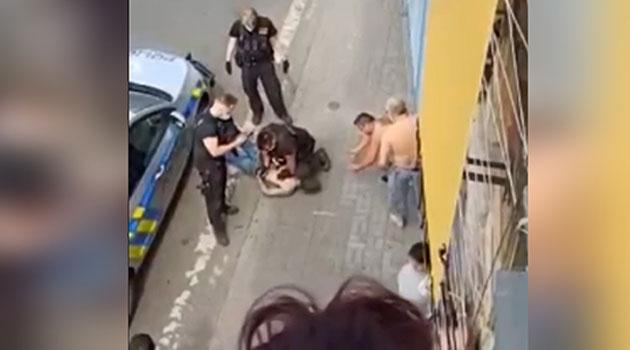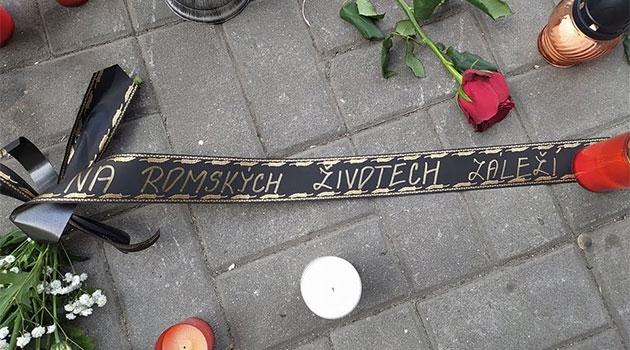Czech Police instructor says kneeling on somebody's neck can be a safe technique, but it's banned in France, Hong Kong, and some states in the USA

The police intervention after which 46-year-old Stanislav Tomáš died in Teplice on Saturday has again unleashed discussion of whether kneeling on somebody’s neck leads to fatal results. The same discussion was held after the death of the Black man George Floyd in the USA last year.
The Czech Police and some police instructors claim the tactic is fine and will not necessarily cause death. “The case in Teplice was not about brutality and racism, those officers intervened against a dangerous man who posed a risk to himself and those around him,” claims Pavel Černý, a retired lieutenant colonel and international police instructor, in an intervew for ROMEA TV.
Černý travels the world teaching police units how to intervene against criminals and terrorists. He frequently does this in countries that are decidedly not the safest in the world.
The force that police are able to use when detaining perpetrators is not concretely specified by the Czech law on the police. That legislation generally states that the techniques to be used are holds, grabs, punches and kicks.
Whether a police officer can kneel on somebody’s neck or not is not addressed by the legislation. “The officer is kneeling on the man between the neck and the back, or maybe right on the neck, which is a standard restraint, a technique for rendering somebody immobile, that is taught absolutely everywhere,” the police instructor said while watching the video footage of the intervention against Mr Tomáš in Teplice.
According to the instructor, the police officer doing the kneeling does not strangle the man, but just fixes his head in place and therefore his entire body. Attorney Miroslav Krutina, however, disagrees with that and warns that it greatly depends on which area of the body the officer is actually kneeling.
“Kneeling is quite a dangerous instrument,” Krutina said on the CNN Prima News channel’s 360° program, adding that he has consulted the intervention with a Police Academy that trains officers in such methods. “Kneeling that would aim for the neck decidedly does not belong among the range of safe procedures. The reason is that it’s difficult to control the force of the pressure exerted,” he said, adding that in tense moments the technique can cause serious injury or strangulation.
“If it were to be demonstrated that the kneeling was directly on the nape of the neck or on the neck itself, then it would not be proportionate,” the attorney said, adding that it cannot be determined from the video footage available where exactly the officer knelt. Police instructor Černý disagrees and even claimed that “the leg sometimes even has to be directly on the neck, or better said, on the nape of the neck.”
In the police instructor’s view, it is impossible for the officer’s knee to block the carotid artery. “The position is cleverly designed to fix the person in place,” the police instructor told ROMEA TV.
According to Ondřej Moravčík, spokesperson for the Police Presidium, officers must pay attention to the principles of legality and proportionality when intervening. “The officer must assess the situation and decide which means of force will make it possible to achieve a purpose that is lawful and essential to overcome the resistance or the escape of the person being intervened against,” Moravčík previously explained to news server Aktuálně.cz.
At the close of the video that was published on social media, it can be seen that the man stops making any physical or vocal reactions. “If the person is quiet, stops shouting, stops moving, then it would be time to start testing his vital signs,” the police trainer said while watching the closing phase of the video of the police intervention, when Mr Tomáš stopped moving and shouting.
Despite the video footage, police have claimed that Mr Tomáš did not collapse until he was in the ambulance called to the scene. In the video, however, it can be seen that this collapse happened while he was prone on the sidewalk, immediately after the officers intervened.
Reporter Richard Samko, who watched the footage together with the police instructor, asked him whether the officers actually proceeded correctly if the video shows that the man had not been moving for about 30 seconds while the officer’s knee remaineds on his neck; the instructor said: “The patrol is beginning to examine what’s going on with him. He isn’t communicating anymore, but we can’t assess what happened there, what kinds of pressures were exerted.”
Kneeling on somebody’s neck as a police technique was addressed from all possible angles after the death of George Floyd. The US tragedy was not the first incident during which this method has been criticized.
In France, Hong Kong, and the USA there are several cases known in which kneeling on somebody’s neck contributed to the death of a person arrested by police. After the death of George Floyd, police officers in France stopped using the technique and have also stopped teaching it at their police academies.
“During arrests it will be forbidden to apply pressure to the neck or nape of the neck,” the then-Interior Minister of France, Christophe Castaner, announced at the time. Moreover, many US police precincts banned the technique after the anti-war protests of the 1960s.
Professor Seth Stoughton, a former police officer and author of a book on how police in the USA use force, has warned that kneeling on the neck is far from being a tactic that poses little risk to those involved. “If correctly used, pressure on the neck could be relatively safe. However, the problem is that for officers it is quite difficult to use the hold correctly, and at the same time there is a big risk that they will use it incorrectly,” the professor previously told CNN.
The Czech police instructor said it is important to obey the instructions of police officers when they intervene. “If the person against whom the officers are intervening obeys all their instructions, then nothing can ever happen to him, but if an officer fails, he should be investigated and prosecuted,” the instructor told ROMEA TV.
